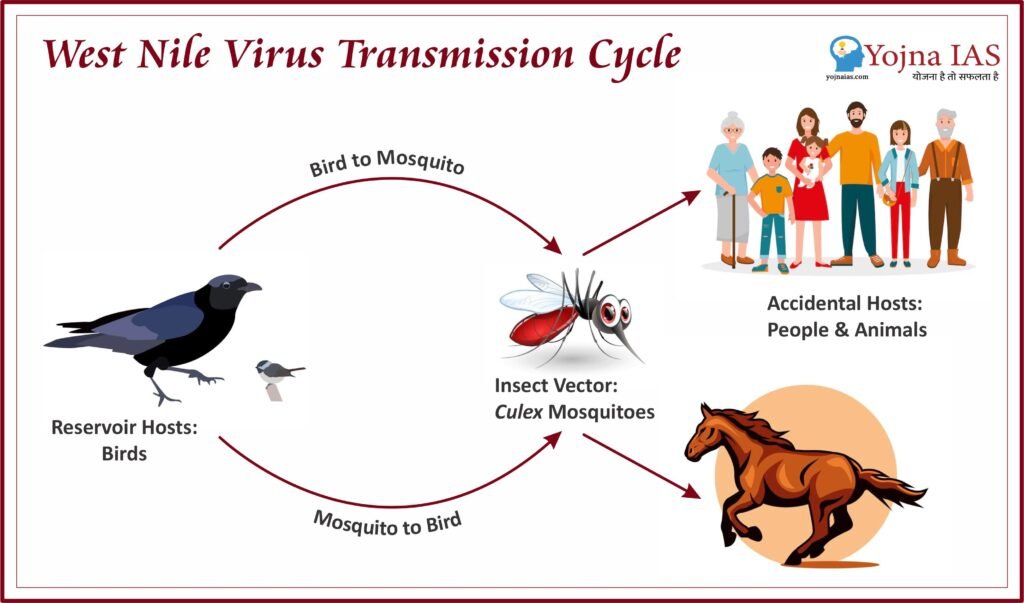11 May 2024 West Nile Fever
This article covers ‘Daily Current Affairs’ and the topic details of “West Nile Fever”. This topic is relevant in the “Science and Technology” section of the UPSC CSE exam.
Why in the News?
The Kerala government has revealed that cases of West Nile fever have resurfaced in the districts of Thrissur, Malappuram, and Kozhikode. This disease was initially identified in Kerala in 2011.
About West Nile Fever
- West Nile Fever is caused by the West Nile virus (WNV), an RNA virus that is transmitted to humans via the bite of an infected mosquito.
- Mosquitoes belonging to the Culex genus are typically recognised as the primary carriers of WNV, while birds act as reservoir hosts. This virus is categorised within the Flaviviridae family and the flavivirus genus. It is prevalent across several regions, including Africa, Europe, the Middle East, North America, and West Asia.
- The initial isolation of the virus occurred in a woman from the West Nile district of Uganda in 1937. Subsequently, in 1953, the virus was detected in birds in the Nile Delta region, as reported by the World Health Organization.
Transmission
- The primary mode of transmission of the West Nile virus to humans is through the bite of Culex genus mosquitoes that are infected with the virus.
- These mosquitoes become carriers of the virus when they feed on infected birds, which are the primary reservoirs for the virus. Once infected, mosquitoes can then pass on the virus to humans and other animals when they bite and feed on blood.
- It’s crucial to understand that West Nile Fever is typically not transmitted directly from one person to another. However, in rare instances, transmission can occur through avenues like organ transplantation, blood transfusion, or from mother to child during pregnancy or breastfeeding.

Symptoms of West Nile Fever
The vast majority of individuals infected with West Nile virus (around 80%) experience no symptoms at all. However, for those who do develop symptoms, they can range from mild and flu-like to severe and debilitating.
Common symptoms of West Nile fever include:
- Fever
- Headache
- Body aches
- Joint pain
- Fatigue
- Nausea
- Vomiting
Symptoms of severe cases:
- neck stiffness
- disorientation
- Tremors
- Seizures
- Paralysis
- Vision loss
Treatment and prevention of West Nile Fever
- Currently, there is no specific antiviral treatment available for West Nile Fever. Treatment is primarily supportive and focuses on managing symptoms to help the body fight off the infection.
- In mild cases, rest, hydration, and over-the-counter pain relievers may be sufficient to alleviate symptoms. In more severe cases, hospitalisation may be necessary to provide intravenous fluids, pain management, and respiratory support if needed.
- Patients with severe neurological complications may require intensive care and monitoring to prevent further complications. Physical therapy and rehabilitation may also be necessary for individuals who experience long-term neurological effects of the infection.
- Prevention is key in managing West Nile Fever, and efforts to control mosquito populations, avoid mosquito bites, and reduce exposure to infected mosquitoes are crucial in preventing the spread of the virus.
Prevention
- Preventing West Nile Fever relies heavily on controlling mosquito populations and minimising human-mosquito contact. This includes implementing mosquito control measures such as larval control, adult mosquito control through insecticides, and environmental management to reduce mosquito breeding sites.
- Public health awareness campaigns play a crucial role in educating the public about the risks associated with West Nile Fever and promoting preventive measures such as using mosquito repellents, wearing long sleeves and pants, and installing screens on windows and doors to keep mosquitoes out.
Diagnosis
The detection of West Nile virus infection can be accomplished through various testing methods:
- Measurement of IgG antibody seroconversion (or a significant increase in antibody titers) in two consecutive specimens collected one week apart using enzyme-linked immunosorbent assay (ELISA).
- Utilisation of IgM antibody capture enzyme-linked immunosorbent assay (ELISA).
- Application of neutralisation assays.
- Viral detection using reverse transcription polymerase chain reaction (RT-PCR) assay.
- Isolation of the virus through cell culture techniques.
In West Nile virus-infected patients, IgM antibodies can typically be identified in nearly all cerebrospinal fluid (CSF) and serum specimens obtained at the time of their clinical presentation. Furthermore, serum IgM antibody levels may persist for more than a year following infection.
Download Yojna daily current affairs eng med 11th May 2024
Prelims practise question
Q1. Consider the following statements:
- In tropical areas, the transmission of Zika virus disease occurs through the same mosquito responsible for spreading dengue fever.
- Zika virus disease can also be transmitted through sexual contact.
Which of the statements given above is/are correct?
(a) 1 only
(b) 2 only
(c) Both 1 and 2
(d) Neither 1 nor 2
Answer: C
Mains practise questions
Q1. What collaborative efforts are underway between scientists, policymakers, and local communities to address the challenges posed by the thawing of permafrost and the emergence of new viruses?
I am a content developer and have done my Post Graduation in Political Science. I have given 2 UPSC mains, 1 IB ACIO interview and have cleared UGC NET JRF too.


No Comments